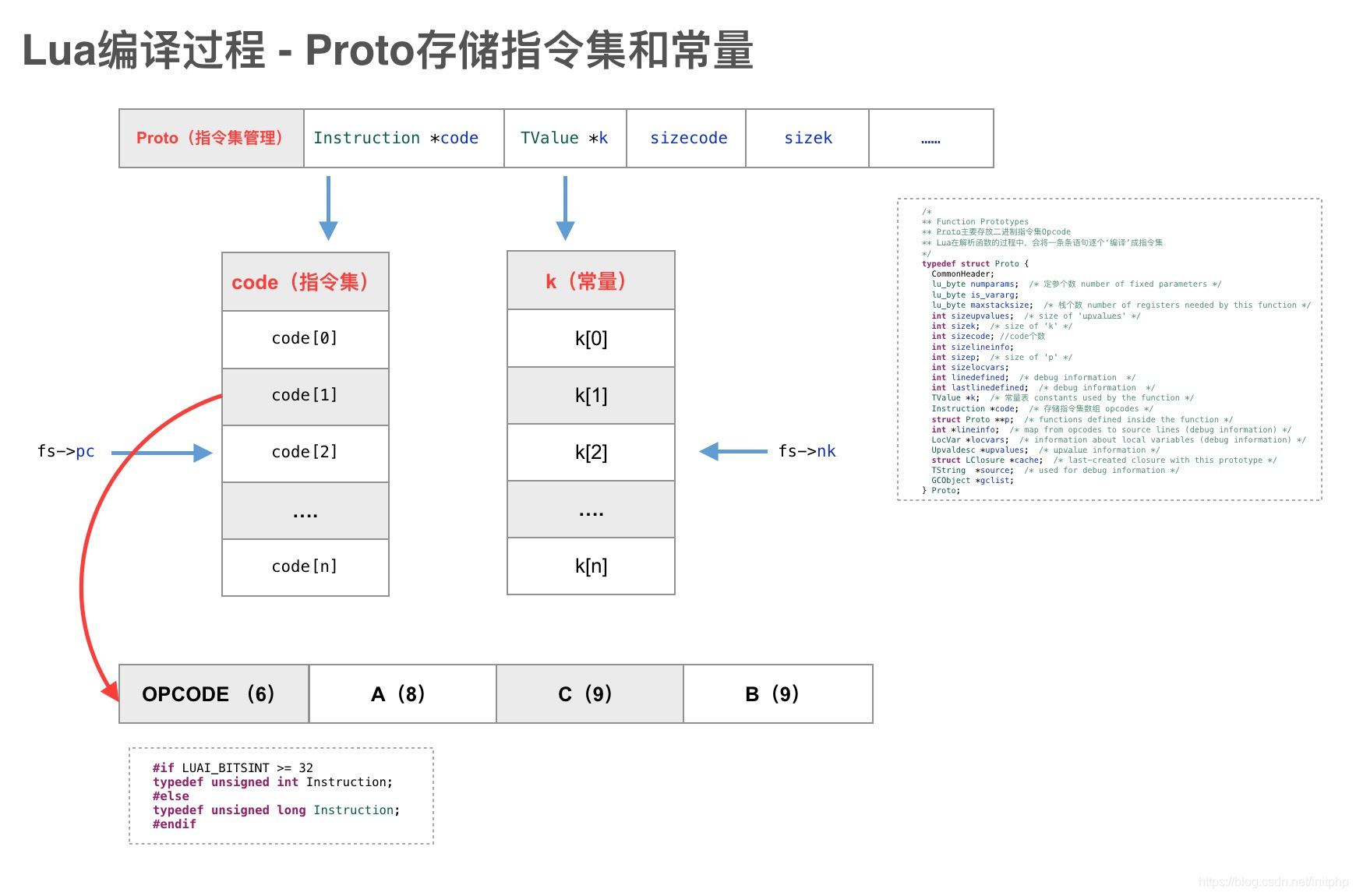|
|
目录
一、虚拟机篇 - 指令集存储数据结构Proto
二、虚拟机篇 - Opcode的定义和宏函数
三、虚拟机篇 - 核心函数luaK_codeABC和luaK_codeABx
四、虚拟机篇 - 常量处理函数addk
上一篇我们讲解了语义的解析编译过程。我们基本知道了Lua的代码是一遍解析文件,一遍编译成字节码指令的。这一节,我们主要讲一下lcode.c文件,Opcode是如何生成的。
一、虚拟机篇 - 指令集存储数据结构Proto
上一篇,我们有讲到Proto是主要用来存储指令集的。
指令集存放:解析完毕的指令集,都会放置到Proto->code[n]上,code是一个数组形式存储。FuncState->pc指向下一个code的地址。Proto结构挂载在FuncState函数栈状态结构上。
常量存放:如果是常量,则先设置到Lua的栈上lua_State。同时也将值设置到Proto->k[n]上,所以k主要是用于存放常量的数组。
所以,看明白整体的指令集存放结构后,我们就可以通盘看一下lcode.c里面相关的核心函数了。

二、虚拟机篇 - Opcode的定义和宏函数
lcode.c文件中,主要对常用的操作符函数进行了封装。而真正最底层的Opcode的定义和函数主要在lopcodes.h文件中。
首先看一下字节码操作符,定义了一个枚举的类型,值从0开始。
typedef enum {
/*----------------------------------------------------------------------
name args description
------------------------------------------------------------------------*/
OP_MOVE,/* A B R(A) := R(B) */
OP_LOADK,/* A Bx R(A) := Kst(Bx) */
OP_LOADKX,/* A R(A) := Kst(extra arg) */
OP_LOADBOOL,/* A B C R(A) := (Bool)B; if (C) pc++ */
OP_LOADNIL,/* A B R(A), R(A+1), ..., R(A+B) := nil */
OP_GETUPVAL,/* A B R(A) := UpValue[B] */
OP_GETTABUP,/* A B C R(A) := UpValue[B][RK(C)] */
OP_GETTABLE,/* A B C R(A) := R(B)[RK(C)] */
..........
OP_VARARG,/* A B R(A), R(A+1), ..., R(A+B-2) = vararg */
OP_EXTRAARG/* Ax extra (larger) argument for previous opcode */
} OpCode;
//操作指令从0开始计算,所以总的值是 OP_EXTRAARG + 1
#define NUM_OPCODES (cast(int, OP_EXTRAARG) + 1)
指令集主要存放在code[n]数组上,code的类型是Instruction,而Instruction在宏定义中是一个32位的unsigned int类型
lopcodes.h文件中,通过定义CREATE_ABC、CREATE_ABx、CREATE_Ax定义三个不同的指令集生成函数。
生成函数的主要逻辑就是位运算,在32位int类型中,切割成4个位置,放置操作指令。前面6位放置Opcode操作指令,8位放置操作指令A,9位放置操作指令B,9位放置操作指令C。
//位运算
#define CREATE_ABC(o,a,b,c) ((cast(Instruction, o)<<POS_OP) \
| (cast(Instruction, a)<<POS_A) \
| (cast(Instruction, b)<<POS_B) \
| (cast(Instruction, c)<<POS_C))
#define CREATE_ABx(o,a,bc) ((cast(Instruction, o)<<POS_OP) \
| (cast(Instruction, a)<<POS_A) \
| (cast(Instruction, bc)<<POS_Bx))
#define CREATE_Ax(o,a) ((cast(Instruction, o)<<POS_OP) \
| (cast(Instruction, a)<<POS_Ax))
/*
** size and position of opcode arguments.
*/
#define SIZE_C 9 //指令C
#define SIZE_B 9 //指令B
#define SIZE_Bx (SIZE_C + SIZE_B)
#define SIZE_A 8 //指令A
#define SIZE_Ax (SIZE_C + SIZE_B + SIZE_A)
#define SIZE_OP 6 //操作符6位
#define POS_OP 0
#define POS_A (POS_OP + SIZE_OP) //6
#define POS_C (POS_A + SIZE_A) //14
#define POS_B (POS_C + SIZE_C) //23
#define POS_Bx POS_C //14
#define POS_Ax POS_A
三、虚拟机篇 - 核心函数luaK_codeABC和luaK_codeABx
在lcode.c中,我们可以看到luaK_codeABC和luaK_codeABx函数是最基础的生成Opcode指令集的函数。
两个函数都调用CREATE_AB*宏函数,实现Opcode生成。并通过luaK_code函数将指令集存放到Proto->code[n]数组上。
/*
** Format and emit an 'iABC' instruction. (Assertions check consistency
** of parameters versus opcode.)
** 生成指令集
*/
int luaK_codeABC (FuncState *fs, OpCode o, int a, int b, int c) {
lua_assert(getOpMode(o) == iABC);
lua_assert(getBMode(o) != OpArgN || b == 0);
lua_assert(getCMode(o) != OpArgN || c == 0);
lua_assert(a <= MAXARG_A && b <= MAXARG_B && c <= MAXARG_C);
return luaK_code(fs, CREATE_ABC(o, a, b, c));
}
/*
** Format and emit an 'iABx' instruction.
** 生成指令集
*/
int luaK_codeABx (FuncState *fs, OpCode o, int a, unsigned int bc) {
lua_assert(getOpMode(o) == iABx || getOpMode(o) == iAsBx);
lua_assert(getCMode(o) == OpArgN);
lua_assert(a <= MAXARG_A && bc <= MAXARG_Bx);
return luaK_code(fs, CREATE_ABx(o, a, bc));
}
/*
** Emit instruction 'i', checking for array sizes and saving also its
** line information. Return 'i' position.
** Opcode存放在Proto结构上
** 其中f->code数组用于存放code
** fs->pc主要是计数器,标记code的个数及数组下标
*/
static int luaK_code (FuncState *fs, Instruction i) {
Proto *f = fs->f;
dischargejpc(fs); /* 'pc' will change */
/* put new instruction in code array */
luaM_growvector(fs->ls->L, f->code, fs->pc, f->sizecode, Instruction,
MAX_INT, "opcodes");
f->code[fs->pc] = i;
/* save corresponding line information */
luaM_growvector(fs->ls->L, f->lineinfo, fs->pc, f->sizelineinfo, int,
MAX_INT, "opcodes");
f->lineinfo[fs->pc] = fs->ls->lastline;
return fs->pc++;
}
从luaK_nil函数中,我们也能看到,最终调用了luaK_codeAB*基础函数,实现指令集Opcode的生成
void luaK_nil (FuncState *fs, int from, int n) {
Instruction *previous;
int l = from + n - 1; /* last register to set nil */
if (fs->pc > fs->lasttarget) { /* no jumps to current position? */
previous = &fs->f->code[fs->pc-1];
if (GET_OPCODE(*previous) == OP_LOADNIL) { /* previous is LOADNIL? */
int pfrom = GETARG_A(*previous); /* get previous range */
int pl = pfrom + GETARG_B(*previous);
if ((pfrom <= from && from <= pl + 1) ||
(from <= pfrom && pfrom <= l + 1)) { /* can connect both? */
if (pfrom < from) from = pfrom; /* from = min(from, pfrom) */
if (pl > l) l = pl; /* l = max(l, pl) */
SETARG_A(*previous, from);
SETARG_B(*previous, l - from);
return;
}
} /* else go through */
}
luaK_codeABC(fs, OP_LOADNIL, from, n - 1, 0); /* else no optimization */
}
四、虚拟机篇 - 常量处理函数addk
前面我们讲过,常量会放置到Proto->k[n]上,同时也会放置到Lua的栈上。常量的处理主要通过addk实现的。
我们以字符串处理为例,可以看一下代码的具体实现。
/*
** Add a string to list of constants and return its index.
*/
int luaK_stringK (FuncState *fs, TString *s) {
TValue o;
setsvalue(fs->ls->L, &o, s);
return addk(fs, &o, &o); /* use string itself as key */
}
static int addk (FuncState *fs, TValue *key, TValue *v) {
lua_State *L = fs->ls->L;
Proto *f = fs->f;
TValue *idx = luaH_set(L, fs->ls->h, key); /* index scanner table */
int k, oldsize;
if (ttisinteger(idx)) { /* is there an index there? */
k = cast_int(ivalue(idx));
/* correct value? (warning: must distinguish floats from integers!) */
if (k < fs->nk && ttype(&f->k[k]) == ttype(v) &&
luaV_rawequalobj(&f->k[k], v))
return k; /* reuse index */
}
/* constant not found; create a new entry */
oldsize = f->sizek;
k = fs->nk;
/* numerical value does not need GC barrier;
table has no metatable, so it does not need to invalidate cache */
setivalue(idx, k);
luaM_growvector(L, f->k, k, f->sizek, TValue, MAXARG_Ax, "constants");
while (oldsize < f->sizek) setnilvalue(&f->k[oldsize++]);
setobj(L, &f->k[k], v);
fs->nk++;
luaC_barrier(L, f, v);
return k;
}
————————————————
版权声明:本文为CSDN博主「老码农zhuli」的原创文章,遵循CC 4.0 BY-SA版权协议,转载请附上原文出处链接及本声明。
原文链接:https://blog.csdn.net/initphp/article/details/105274652
|
|